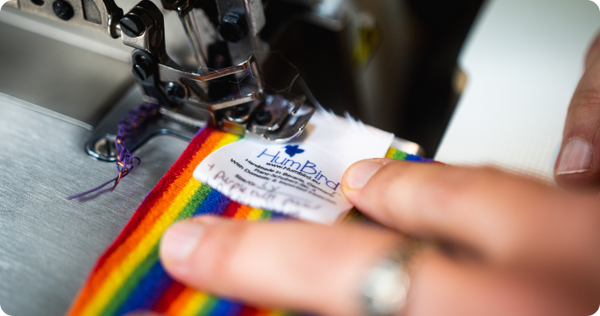Wool Care
Jersey Wool and all non interlock
- Cleaning: Please use Unicorn Fibre Wash on your jersey items. Beyond Clean/Power Scour is too strong for regular use on non-interlock items. Use Beyond Clean when a deep wash is required.
- Hand washing is the most gently on your items and is what we recommend.
- Conditioning; Unicorn Beyond Soft or Fibre Rinse are important to use after washing. While you do not need to condition your jersey after every wash, please condition with regularity of the wool fibers can weaken. This will result your wool clothing being less soft and more prone to potential holes. We also recommend lano-ing your jersey items occasionally for the best conditioning.
WASHING INTERLOCK WOOL and HOW TO LANOLIZE
This guide is written specifically for interlock wool.
WASH YOUR WOOL! You must get all the dirt and urine out of the wool before lanolizing. Make sure your wool is CLEAN! Washing and lanolizing are two different steps.
Do not skip thoroughly washing your wool because it will cause damage over time. Urine salts and any soiling will become trapped on the wool fiber and sealed in by lanolin. This will cause unnecessary stress on the wool fibers by drying them out and making the fibers less stretchy and stiff over time, which can also lead to seam stretching, thinning, and color distortion. Urine is also acidic and when sealed into the wool can eat away at it.
Hand washing:
1. Fill your washbasin with tepid water between 86 and 95F (35C). For very dirty wool choose a warmer temperature in this range. If you do not have access to a thermometer use a temperature that feels like warm bath water.
2. Add Wool Wash. We recommend Unicorn Beyond Clean (unscented version) or Unicorn Power Scour (whatever products you chose, follow the manufacture’s instructions). When using Unicorn add about ½ teaspoon to your water basin and mix. This amount may vary according to your specific situation. Less is more -- Unicorn is VERY concentrated. Start with less and adjust as needed (more facts about washing wool below). Per Unicorn’s recommendation, soak for up to 15 minutes. Periodically while soaking, gently squeeze the item while submerged in the water to make sure water solution has penetrated throughout all the fibers.
3. Rinse your wool until the water is clear. Either rinse under the faucet with similar temperature water as what you soaked in, or empty your bath water, refill with clean water that is a similar temperature and let your wool soak again. Remember to gently squeeze your wool again while rinsing to ensure the fibers are being rinsed out.In making sure that the wool is as clean as possible, you will also want to be sure that the wool wash is completely rinsed before lanolizing. Rinse until the water is clear.
*If stained, heavily soiled, or if your wash water is very dirty, repeat the above steps.
Lanolizing:
1. Make lano milk. Take a cup of very hot water, add lanolin (Rule of thumb is one teaspoon per baby wool item. Please adjust according to size. For example, adult leggings need at least a tablespoon) and your emulsifying agent (e-cube, dish soap, baby soap), let dissolve and stir. The resulting mixture will look nice and milky. If your mixture forms a top layer that looks oily, you may need to add more emulsifier.
2. Slowly stir in your lano milk to a warm bath of clean water. Your lano milk should be about the same temperature as your bath water. You can add a few ice cubes to your lano to gently cool it down prior to mixing with your bath water.
Troubleshooting:
- If the lano mixture is not creating a beautiful white milk then you may need to add additional emulsifier.
- If you step away from the lano milk and it cools too much and separates adding hot water will melt it all back together.
- If the temperature of your lano milk and bath water are too different that may “shock” the mixture and solidify some of the lanolin on the surface of the water. Adding very hot water and/or soap MAY fix this situation.
Troubleshooting:
- If the lano mixture is not creating a beautiful white milk then you may need to add additional emulsifier.
- If you step away from the lano milk and it cools too much and separates adding hot water will melt it all back together.
- If the temperature of your lano milk and bath water are too different that may “shock” the mixture and solidify some of the lanolin on the surface of the water. Adding very hot water and/or soap MAY fix this situation.
3. Turn your damp wool inside out and add it to the lano bath.
4. Soak for 20 -30 minutes. Take out the wool and gently squish out the water (never wring out wool!). You can then give them a quick spin in your washing machine (on wool cycle or gentle cycle only) to remove excess water and hang or lay flat to dry. Another method is laying your wool on a towel and rolling it up while pressing it as you go to press out the water, then laying flat to dry.
You may speed up the drying process by placing a box fan near the wool. It is not recommended to lay your wool out in direct sunlight.
You may speed up the drying process by placing a box fan near the wool. It is not recommended to lay your wool out in direct sunlight.
Wool care does not need to be complicated or confusing. Please reach out to one of the admins or post in the Facebook group if you need any help or clarification.
Machine Washing:
Machine washing interlock wool requires the wool or delicate cycle on your washing machine. Unicorn recommends warm water and 1 ounce of Unicorn for normal loads. Use less for lighter soil levels or smaller loads. Again, less is more!
Machine washing interlock wool requires the wool or delicate cycle on your washing machine. Unicorn recommends warm water and 1 ounce of Unicorn for normal loads. Use less for lighter soil levels or smaller loads. Again, less is more!
Recommend Products
· Lanolin. Any solid lanolin will do. You will find that some brands smell more “sheepy” than others but it will work just as well.
Here are some brands that HumBird customers like and recommend:
Here are some brands that HumBird customers like and recommend:
NOW Lanolin (Amazon Prime)
https://www.amazon.com/NOW-Solutions-Lanolin-Pure-7-Ounce/dp/B000I1OYNK?th=1
https://www.amazon.com/NOW-Solutions-Lanolin-Pure-7-Ounce/dp/B000I1OYNK?th=1
Chemisty Connection (Etsy)
https://www.etsy.com/listing/73489507/pure-lanolin-anhydrous-1-lb?ga_order=most_relevant&ga_search_type=all&ga_view_type=gallery&ga_search_query=lanolin&ref=sr_gallery-1-2&organic_search_click=1
https://www.etsy.com/listing/73489507/pure-lanolin-anhydrous-1-lb?ga_order=most_relevant&ga_search_type=all&ga_view_type=gallery&ga_search_query=lanolin&ref=sr_gallery-1-2&organic_search_click=1
Yooki Wool ($5 flat rate shipping)
https://www.yookiwool.com/collections/wool-care/products/solid-lanolin-sweet-tea-n-biscuits?variant=20194890219579
https://www.yookiwool.com/collections/wool-care/products/solid-lanolin-sweet-tea-n-biscuits?variant=20194890219579
· Wool Wash. We recommend Unicorn wool washing products. Why? Because we get consistent and great results.
It is a small, family run business out of the US, started because they have an alpaca farm. Unicorn is earth friendly, biodegradable, septic safe, and for use in hard or soft water. Unicorn DOES NOT contain bleach additives, phosphates, enzymes, brighteners, petroleum, stripping agents or dyes.
They are very responsive and excited to answer any and all questions, offer samples, and have great customer service.
http://www.unicornclean.com/
It is a small, family run business out of the US, started because they have an alpaca farm. Unicorn is earth friendly, biodegradable, septic safe, and for use in hard or soft water. Unicorn DOES NOT contain bleach additives, phosphates, enzymes, brighteners, petroleum, stripping agents or dyes.
They are very responsive and excited to answer any and all questions, offer samples, and have great customer service.
http://www.unicornclean.com/
also available at:
Unicorn @ Yooki Wool ($5 flat rate shipping)
https://www.yookiwool.com/collections/wool-care/products/unicorn-power-scour-beyond-clean?variant=7688066949
https://www.yookiwool.com/collections/wool-care/products/unicorn-power-scour-beyond-clean?variant=7688066949
Unicorn @ Nicki’s Diapers (free shipping on orders over $10 *subject to change)
https://www.nickisdiapers.com/unicorn-clean-beyond-clean-wash.html
https://www.nickisdiapers.com/unicorn-clean-beyond-clean-wash.html
· The Fun Stuff! HumBird is collaborating with Yooki Wool to create an exclusive HumBird scent. We are very excited and will keep everyone updated on the progress (they are in the final stages now).
Yooki Wool carries emulsifying cubes (e-cubes), solid lanolin, lavender sachets and Unicorn products. They also have a $5 flat rate shipping (within the US & it’s territories) which is awesome.
https://www.yookiwool.com/collections/wool-care
https://www.yookiwool.com/collections/wool-care
· Stains.
Unicorn Beyond Clean or Power Scour (same except PS is lightly scented)
http://www.unicornclean.com/shop/unicorn-beyond-clean
http://www.unicornclean.com/shop/unicorn-beyond-clean
HumBird wants your wool to last!
That is why we do not recommend using mainstream laundry detergents. Common household laundry detergents are not appropriate for wool especially if it contains enzymes. Enzymes are in laundry detergents to eat protein stains. Wool is made of protein. This can cause accelerated wear by breaking down the weakened fibers.
That is why we do not recommend using mainstream laundry detergents. Common household laundry detergents are not appropriate for wool especially if it contains enzymes. Enzymes are in laundry detergents to eat protein stains. Wool is made of protein. This can cause accelerated wear by breaking down the weakened fibers.
We also no longer recommend lanolin rich wool washes such as Eucalan. The biggest thing to remember is that washing and lanolizing are two different steps. Lano-rich wool washes contain lanolin and can impede proper washing. It is our (and other wool makers’) opinion that the lanolin in it is enough to hold on to some of the soil on the wool but not enough of it to be useful towards moisture protection for diaper cover use.
Tips and Tricks from the Admin
· Don't be afraid to rewash. If your wash water is really dirty, give them additional baths to get all the gunk out. This is especially true if you have a piece of wool that may have several layers of lano and soil. Don’t fret! You can get them clean!
· Always lanolize inside out. Sometimes you can get a lano spot, this will not hurt your wool and will quickly wear off after a few wears.
· Washing in a white or light colored basin will really allow you to see if the wool is getting clean. It can be difficult to see if your water is still dirty or if there is still wool wash in a dark colored basin, like a metal sink. A white plastic dish basin works great.
· A baby bath tub is also good for washing. It's big enough to lay the wool flat in the water, allow agitation, but also small enough to maintain control over the water and soap amounts that are needed.
· To temper the lano milk so there is less risk of separation, add some of the water from the basin to the lano milk and stir before pouring into the basin and stirring to mix.


